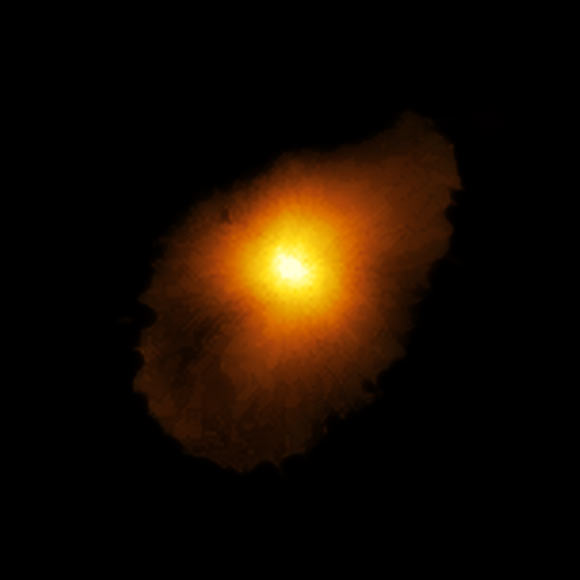Astronomers using the Atacama Large Millimeter/submillimeter Array (ALMA) have discovered an extremely distant galaxy that looks surprisingly like our own Milky Way Galaxy. Named SPT-S J041839-4751.9, this galaxy is located 12 billion light-years away and is strongly gravitationally lensed by a foreground galaxy. While SPT-S J041839-4751.9 doesn’t appear to have spiral arms, it has at least two features typical of our Milky Way: a rotating disk and a bulge, the large group of stars packed tightly around the galactic center.

A reconstructed image of SPT-S J041839-4751.9. Image credit: ALMA / ESO / NAOJ / NRAO / Rizzo et al, doi: 10.1038/s41586-020-2572-6.
In the early Universe, young galaxies were still in the process of forming, so astronomers expect them to be chaotic and lacking the distinct structures typical of more mature galaxies like the Milky Way.
“Studying distant galaxies like SPT-S J041839-4751.9 is fundamental to our understanding of how galaxies formed and evolved,” said lead author Francesca Rizzo of the Max Planck Institute for Astrophysics and colleagues.
“This galaxy is so far away we see it when the Universe was just 10% of its current age because its light took 12 billion years to reach Earth.”
“By studying it, we are going back to a time when these baby galaxies were just beginning to develop.”
“Because these galaxies are so far away, detailed observations with even the most powerful telescopes are almost impossible as the galaxies appear small and faint.”
Rizzo and co-authors overcame this obstacle by using a nearby galaxy as a powerful magnifying glass allowing ALMA to see into the distant past in unprecedented detail.

SPT-S J041839-4751.9 is gravitationally lensed by a foreground galaxy, appearing in the sky as a near-perfect ring of light. Image credit: ALMA / ESO / NAOJ / NRAO / Rizzo et al, doi: 10.1038/s41586-020-2572-6.
The gravitationally lensed SPT-S J041839-4751.9 appears as a near-perfect ring of light around the foreground galaxy, thanks to their almost exact alignment.
The astronomers reconstructed the distant galaxy’s true shape and the motion of its gas from the ALMA data using a new computer modeling technique.
“This result represents a breakthrough in the field of galaxy formation, showing that the structures that we observe in nearby spiral galaxies and in our Milky Way were already in place 12 billion years ago,” Rizzo said.
“The big surprise was to find that this galaxy is actually quite similar to nearby galaxies, contrary to all expectations from the models and previous, less detailed, observations,” said co-author Dr. Filippo Fraternali, an astronomer in the Kapteyn Astronomical Institute at the University of Groningen.
“What we found was quite puzzling; despite forming stars at a high rate, and therefore being the site of highly energetic processes, SPT-S J041839-4751.9 is the most well-ordered galaxy disk ever observed in the early Universe,” said co-author Dr. Simona Vegetti, an astronomer at the Max Planck Institute for Astrophysics.
“This result is quite unexpected and has important implications for how we think galaxies evolve.”
The discovery, reported in a paper in the journal Nature, suggests the early Universe may not be as chaotic as once believed and raises many questions on how a well-ordered galaxy could have formed so soon after the Big Bang.
_____
F. Rizzo et al. 2020. A dynamically cold disk galaxy in the early Universe. Nature 584, 201-204; doi: 10.1038/s41586-020-2572-6







